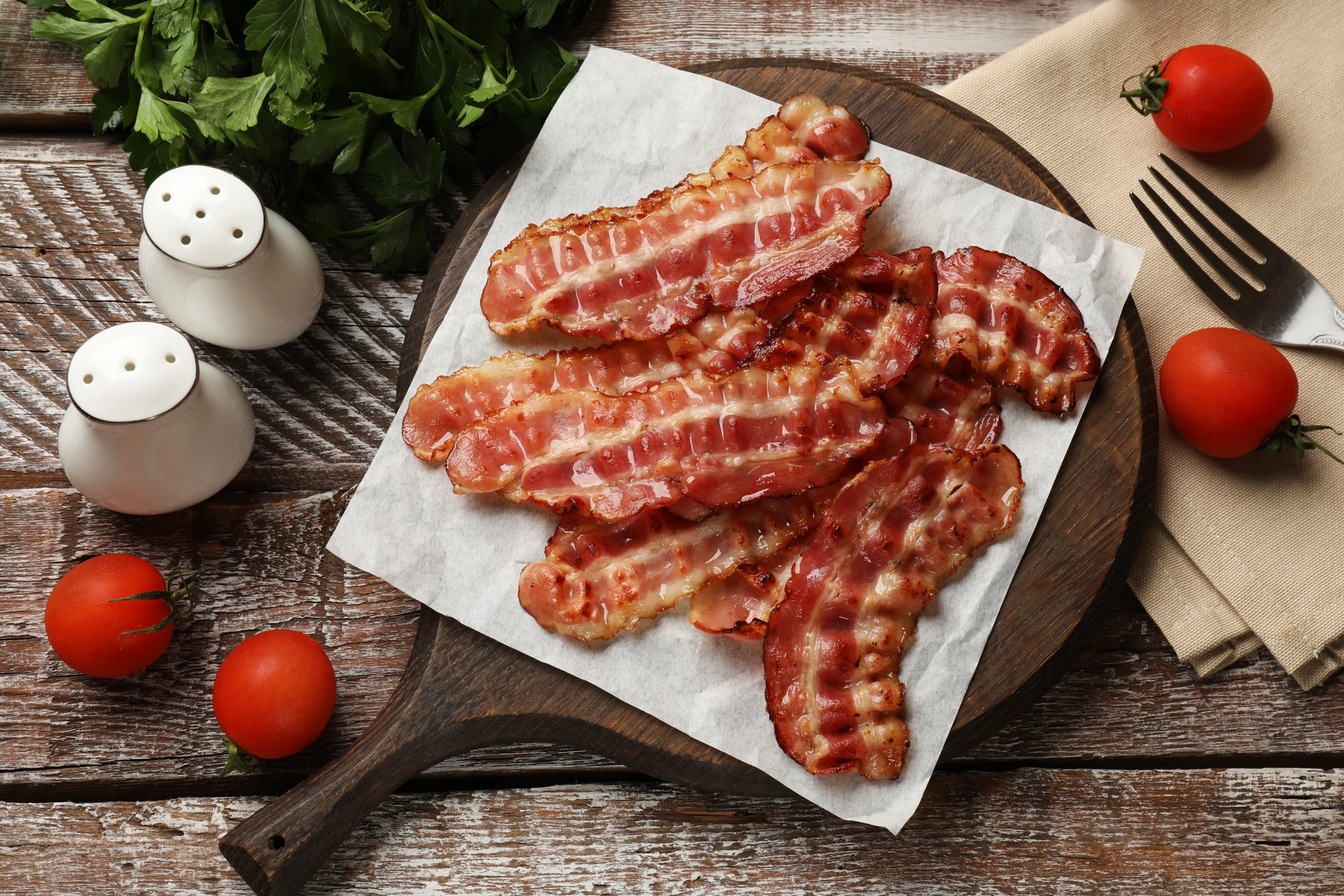Table Of Contents
-
Key Highlights
-
Are Bacon and Processed Meats Safe for People with Diabetes?
-
Bacon Nutrition Facts: What Diabetics Need to Know
-
Health Risks of Eating Bacon with Diabetes: Latest Research
-
How Much Bacon Is Safe? Realistic Guidelines for People with Diabetes
-
Healthier Bacon Alternatives for Diabetics
-
How to Include Bacon in a Diabetes Meal Plan (If Desired)
-
Frequently Asked Questions About Bacon and Diabetes
-
Conclusion
-
References
Key Highlights
- Bacon should be limited for diabetics due to high saturated fat and sodium content, which increase cardiovascular disease risk—already elevated in diabetes patients.
- Zero carbohydrates but hidden impacts: While bacon won’t spike blood sugar directly, its fat and sodium load affects long-term diabetes complications.
- Medical guidelines recommend avoidance: CDC, Harvard, and MedlinePlus all advise limiting or avoiding processed meats like bacon for optimal diabetes management.
- Occasional consumption may be acceptable with strict portion control (1-2 slices, not daily) and balanced meal planning with high-fiber vegetables.
- Increased diabetes risk for others: Research shows each additional serving of bacon increases Type 2 diabetes risk by 46% in non-diabetics.
- Better alternatives exist: Turkey bacon, Canadian bacon, lean ham, and plant-based options offer similar flavors with reduced health risks.
- Personalized approach essential: Always consult your healthcare provider or registered dietitian for individualized guidance on processed meat consumption.
Are Bacon and Processed Meats Safe for People with Diabetes?
The consensus among major health organizations is clear: bacon and processed meats should be limited or avoided by people with diabetes. The CDC’s 2024 Diabetes Kickstart Guide explicitly lists bacon as a food to minimize, while Harvard’s Healthy Eating Plate recommends avoiding processed meats entirely for optimal health outcomes.
This isn’t just about blood sugar management—it’s about preventing the serious complications that diabetes can bring. When you have diabetes, your risk for cardiovascular disease is already 2-4 times higher than someone without diabetes. Adding regular processed meat consumption, including bacon, compounds these risks significantly.
What Makes Processed Meats Problematic for Diabetics?
Processed meats like bacon undergo curing, smoking, or chemical preservation that creates several concerning compounds:
- Nitrates and nitrites: These preservatives can form potentially harmful compounds during digestion
- Advanced glycation end products (AGEs): Created during high-heat cooking, these promote inflammation
- Excessive sodium: Contributes to hypertension, a common diabetes complication
- Saturated fat concentration: Increases LDL cholesterol and cardiovascular disease risk
 Important Medical Consideration
Important Medical Consideration
The MedlinePlus diabetes meal planning guidelines emphasize that people with diabetes should prioritize lean proteins and limit foods high in saturated fat and sodium—both abundant in bacon.
Bacon Nutrition Facts: What Diabetics Need to Know
Understanding bacon’s nutritional profile is crucial for making informed decisions about its place in a diabetes meal plan. While bacon contains zero carbohydrates, its other nutritional components present significant concerns for diabetes management.
Nutritional Breakdown: Regular Pork Bacon vs. Alternatives
| Type (1 slice) | Calories | Total Fat | Saturated Fat | Sodium | Protein | Carbs |
|---|---|---|---|---|---|---|
| Regular Pork Bacon | 42 | 3.5g | 1.1g | 137mg | 3.0g | 0g |
| Turkey Bacon | 30 | 1.3g | 0.4g | 140mg | 2.0g | 0g |
| Canadian Bacon | 25 | 1.0g | 0.3g | 170mg | 4.0g | 0g |
| Lean Ham | 23 | 0.8g | 0.3g | 158mg | 3.5g | 0g |
The Hidden Impact on Diabetes Management
While bacon’s zero carbohydrate content means it won’t cause immediate blood sugar spikes, its high fat content can affect glucose metabolism in other ways. High-fat meals can slow gastric emptying, potentially affecting the timing and effectiveness of diabetes medications, particularly insulin.
More importantly, the saturated fat in bacon contributes to insulin resistance over time. A diet high in saturated fats can make your body’s cells less responsive to insulin, making blood sugar control more challenging in the long run.
Health Risks of Eating Bacon with Diabetes: Latest Research
Recent scientific evidence provides compelling reasons for people with diabetes to limit bacon consumption. The research consistently shows that regular processed meat intake increases the risk of diabetes complications and worsens overall health outcomes.
Cardiovascular Disease Risk
A comprehensive 2023 study published in Harvard Health revealed that each additional daily serving of processed meat, including bacon, increases diabetes risk by 46% in non-diabetic individuals. For those already managing diabetes, the implications are even more serious.
The research shows that people with diabetes who regularly consume processed meats have:
- Higher rates of heart disease and stroke
- Increased likelihood of developing diabetic nephropathy (kidney disease)
- Greater difficulty achieving target blood pressure levels
- More frequent hospitalizations for cardiovascular events
Sodium and Blood Pressure Concerns
The high sodium content in bacon poses particular risks for people with diabetes. The American Diabetes Association recommends limiting sodium intake to less than 2,300mg per day, with many diabetes patients needing even stricter limits due to existing hypertension.
Just three slices of bacon provide over 400mg of sodium—nearly 20% of the daily recommended limit. When combined with other processed foods commonly consumed throughout the day, this can quickly lead to excessive sodium intake, worsening blood pressure control and increasing kidney disease risk.
Interactive Bacon Portion Calculator
Calculate the nutritional impact of different bacon portions on your daily limits:
Nutritional Impact:
10 slice(s) of bacon contains:
- Calories: 420 (21.0% of daily intake)
- Total Fat: 35.0g
- Saturated Fat: 11.0g (55.0% of recommended daily limit)
- Sodium: 1370mg (59.6% of recommended daily limit)
- Protein: 30.0g
• Limit to 1-2 slices maximum, no more than twice weekly
• Always pair with high-fiber vegetables
• Consider turkey bacon or Canadian bacon as alternatives
• Monitor blood pressure and glucose response
How Much Bacon Is Safe? Realistic Guidelines for People with Diabetes
While medical guidelines generally recommend avoiding or minimizing bacon consumption, some people with diabetes may choose to include it occasionally. If you decide to include bacon in your meal plan, strict portion control and frequency limitations are essential.
Evidence-Based Portion Recommendations
Based on research from the Federal Practitioner’s 2024 study on low-carbohydrate diets for diabetes, occasional bacon consumption may be acceptable when limited to:
- Frequency: No more than once or twice per week
- Portion size: 1-2 thin slices per serving
- Meal balance: Always paired with high-fiber, low-sodium vegetables
- Cooking method: Baked or air-fried to reduce fat content
Safer Cooking Methods for Diabetics
When you do choose to eat bacon, the cooking method matters significantly for diabetes management:
- Baking: Cook at 400°F on a wire rack to allow fat to drain
- Air frying: Reduces fat content by up to 30% compared to pan-frying
- Grilling: Allows fat to drip away, but watch for charring (creates AGEs)
- Avoid: Pan-frying in its own fat or adding additional oils
Always drain cooked bacon on paper towels and avoid consuming the rendered fat. Never add additional salt or high-sodium seasonings to bacon dishes.
Healthier Bacon Alternatives for Diabetics
Fortunately, several alternatives can provide similar flavors and textures to bacon while offering improved nutritional profiles for diabetes management. These options allow you to enjoy breakfast favorites without compromising your health goals.
Protein-Based Alternatives
Turkey Bacon: Contains about 65% less saturated fat than pork bacon while maintaining similar sodium levels. Choose uncured, low-sodium varieties when possible.
Canadian Bacon: Technically a lean ham, Canadian bacon provides more protein and less fat than regular bacon. It’s still processed, so portion control remains important.
Lean Ham: Thinly sliced lean ham offers bacon-like flavor with significantly less saturated fat. Look for low-sodium, nitrate-free options.
Plant-Based Innovations
Modern plant-based bacon alternatives have improved dramatically in taste and texture. Options made from tempeh, coconut, or pea protein can provide satisfying flavors with:
- No cholesterol or saturated fat
- Lower sodium content (in many brands)
- Added fiber and plant nutrients
- No preservatives or nitrates
Creative Flavor Substitutions
Consider these diabetes-friendly alternatives that provide umami and smoky flavors without processed meat risks:
- Smoked salmon: Rich in omega-3 fatty acids, low in saturated fat
- Grilled portobello mushrooms: Meaty texture with natural umami
- Seasoned chicken sausage: Choose varieties with <2g saturated fat per serving
- Coconut bacon: Smoky coconut flakes seasoned with spices
How to Include Bacon in a Diabetes Meal Plan (If Desired)
If you choose to include bacon in your diabetes management plan, it requires careful consideration of your overall dietary pattern, medication timing, and health status. This decision should ideally be made in consultation with your healthcare team.
Strategic Meal Planning Approaches
When incorporating bacon occasionally, follow these evidence-based strategies:
The Balanced Plate Method: When bacon is included, ensure the rest of your plate consists of:
- 50% non-starchy vegetables (spinach, peppers, tomatoes)
- 25% lean protein or whole grains
- 25% healthy fats (avocado, nuts, olive oil)
- Bacon as a flavor enhancer, not the main protein source
Timing Considerations: Include bacon-containing meals earlier in the day when you’re more active and can better utilize the consumed fats. Avoid bacon at dinner when metabolic rates are slower.
Monitoring Your Response
Track how bacon consumption affects your individual diabetes management:
- Monitor blood glucose levels 2-4 hours after bacon-containing meals
- Track blood pressure readings on days when bacon is consumed
- Note any changes in medication effectiveness or timing needs
- Keep a food diary to identify patterns or sensitivities
Frequently Asked Questions About Bacon and Diabetes
Bacon can be consumed very occasionally by people with Type 2 diabetes, but it should be limited to 1-2 slices no more than once or twice per week. The high saturated fat and sodium content pose cardiovascular risks that are already elevated in diabetes. Always prioritize lean proteins like grilled chicken, fish, or plant-based options for regular consumption.
Bacon contains zero carbohydrates, so it won’t cause immediate blood sugar spikes. However, its high fat content can slow digestion and affect how your body processes other foods in the meal, potentially impacting blood glucose control over several hours. The bigger concern is bacon’s long-term effects on insulin resistance and cardiovascular health.
Turkey bacon is generally a better choice as it contains about 65% less saturated fat than pork bacon. However, it’s still a processed meat with high sodium content, so the same portion control and frequency limitations apply. Canadian bacon or lean ham are even better alternatives with lower fat content and more protein per serving.
Excellent bacon alternatives include scrambled eggs with vegetables, smoked salmon, lean ham, chicken sausage (low-sodium), avocado toast on whole grain bread, Greek yogurt with nuts, or plant-based protein options. These provide satisfying flavors and textures while supporting better diabetes management and heart health.
Medical guidelines suggest limiting bacon consumption to no more than once or twice per week, with strict portion control (1-2 thin slices). Many diabetes specialists recommend avoiding it entirely due to the cardiovascular risks. The frequency should be even less if you have existing heart disease, high blood pressure, or kidney problems alongside diabetes.
While bacon fits the macronutrient profile of low-carb and ketogenic diets due to its zero carbohydrate content, it’s not ideal for diabetics following these eating patterns. The focus should be on unprocessed meats, fish, eggs, and plant-based fats. If bacon is included, it should be occasional and balanced with plenty of low-carb vegetables to optimize health outcomes.
Baking bacon on a wire rack at 400°F or using an air fryer are the healthiest cooking methods as they allow excess fat to drain away. Always drain the cooked bacon on paper towels and avoid consuming the rendered fat. Never add additional salt or high-sodium seasonings, and pair with high-fiber vegetables to balance the meal.
Conclusion
The evidence is clear: while bacon won’t directly spike your blood sugar due to its zero carbohydrate content, it poses significant risks for people managing diabetes. The high saturated fat and sodium content can worsen cardiovascular complications, increase blood pressure, and contribute to long-term insulin resistance—all serious concerns when you’re already managing diabetes.
The safest approach is to treat bacon as an occasional indulgence rather than a regular part of your meal plan. When you do choose to include it, stick to strict portion control (1-2 slices), limit frequency to once or twice weekly maximum, and always balance it with fiber-rich vegetables and lean proteins.
Remember that excellent alternatives exist, from turkey bacon and Canadian bacon to innovative plant-based options that can satisfy your cravings without compromising your health goals. The key is working with your healthcare team to develop a personalized nutrition plan that supports both your diabetes management and your quality of life.
Your diabetes journey is unique, and what works for others may not be ideal for your specific situation. Have you discussed processed meat consumption with your healthcare provider as part of your diabetes management strategy?
References
- Centers for Disease Control and Prevention. (2024). CDC Diabetes Kickstart: Healthy Eating Guide. Retrieved 2024.
- Harvard T.H. Chan School of Public Health. (2024). The Healthy Eating Plate. Retrieved 2024.
- MedlinePlus. (2024). Type 2 Diabetes – Meal Planning. National Institutes of Health.
- Federal Practitioner. (2024). Low-Carbohydrate and Ketogenic Diets for Type 2 Diabetes Management. PMC Article.
- Harvard Health Publishing. (2024). Will eating red meat bring on diabetes? Harvard Medical School.
- New Mexico State University Extension. (2024). Control Your Diabetes for Life. NMSU Cooperative Extension.
- Cook County Health System. (2024). Diabetic Friendly Recipes. Cook County Government.
- USDA FoodData Central. (2024). Nutrition facts for bacon and alternatives. United States Department of Agriculture.
- American Diabetes Association. (2024). Standards of Medical Care in Diabetes. Diabetes Care Guidelines.
- World Health Organization. (2024). Diabetes Management Guidelines. WHO Global Health Observatory.
Disclaimer:
The information provided on MD-Pilot is for educational and informational purposes only. It is not intended as a substitute for professional medical advice, diagnosis, or treatment. Always seek the advice of your physician or other qualified healthcare provider with any questions you may have regarding a medical condition. Never disregard professional medical advice or delay in seeking it because of something you have read on this website.
Recomended Articles
View AllWeekly Health Intel
Get evidence-based health tips, latest research, and exclusive guides delivered weekly




